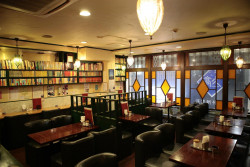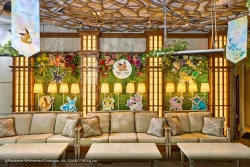
May 20, 2011
Future Fashion
Origami, trash and gender-bending at Tokyo’s cutting-edge clothiers
By Metropolis
Originally published on metropolis.co.jp on May 2011

Recycled polyester dress: Issey Miyake ¥36,750. Photos: Hiroshi Iwasaki 2010

T-shirt: Issey Miyake ¥8,190 Recycled polyester pants: Issey Miyake ¥63,000. Photo by Hiromi Iguchi

Jacket: Phenomenon ¥52,500 Net tank top: Phenomenon ¥26,250. Tank top: Phenomenon ¥12,600. Pants: used ¥5,040. Shirt belt: Phenomenon ¥26,250. Shoes: used ¥37,800. Photo by Hiromi Iguchi

Graphic Print T-Shirt: Vicious East × Candy ¥15,540. Digital Sweat Pants: Astrid Andersen ¥52,500. © Candy
In Act 1 this writer, whose wardrobe is only as varied as the sweatshirts he pairs with his Dickies, visits two very different purveyors of Tokyo’s forwardmost fashion and dresses himself in their respective visions. Among the things he learns: there is no Act 2. For Japan’s fashion innovators, the future is now.
I like to imagine a future where men enjoy clothes as much as women,” says Shogo Yanagi, manager of Candy, an envelope-pushing incubator of trash-A-class fashion that moved from Shinjuku-nichome to Shibuya last year. “We don’t make a distinction between men’s and women’s fashion,” he says. “The store layout is a deliberate attempt to confuse the two.”
I’ll testify to the confusion, and to the fun. In a whirlwind tour of the store’s gender-flouting fashion options, only a single jacket I try on is identifiably masculine. The clothes are sheer loudness, and I’m all smiles.
I’m not the first.
“In Nichome, men would try on dresses,” Yanagi says. “They had so much fun. It was inspiring. Back then the store was about highlighting emerging designers, but now I’m trying to focus on encouraging people to have fun with clothes.”
My many wardrobe changes don’t include any dresses, but they do reshape my perception of what’s at stake when I visit a store that’s poised on fashion’s leading edge.
“Just come in. Try on clothes. We’ll tell you how to wear it, show you the styling. No judgment,” Yanagi says. The notion of a Tokyo fashion hotspot as the place one goes to escape the city’s aesthetic pretenses might be counterintuitive, but given the frailty of our long-suffering egos, it’s also good medicine.
“In the future, I suppose there will be no difference between genders. We want our clothes to be suitable,” Issey Miyake told Telegraph Magazine in September 2010. The occasion for the interview was the release of his latest line, 132 5. At the 132 5 store in Aoyama, gender is again noticeably absent from the clothes I try, though they’re a very different kind of conspicuous.
132 5 is the result of a collaboration with Tsukuba University’s Jun Mitani, whose research deals in the digital modeling of origami. Miyake’s Reality Lab developed a proprietary textile made of recycled plastic bottles and adapted Mitani’s software to design garments for it.
This isn’t Miyake’s most wearable work, but it’s undeniably prescient. And if it looks like something you’d imagine yourself wearing in the distant future, Miyake envisioned precisely that. “It’s important to make clothes for long-term use now, not just one season. We can’t keep throwing things away,” he told Telegraph.
Can a wardrobe of permanence really save the world? Maybe not, and Miyake’s work benefits from a conspicuously affluent patronage, but in an increasingly green-washed marketplace his genius-laden approach to altering fashion’s ecology is as vital as it is sincere. And high-minded though he may be, he makes no grandiose claims about his designs’ impact. For Miyake, design is a means to an end, and success is measured by the quality of the product.
The product is intriguing. On the shelf, folded flat, it’s fractal art. Worn, it retains the visual appeal of its origami-inspired shape without resorting to stiffness. If I feel surprisingly comfortable in 132 5’s hakama-influenced #3 pants, it’s not just because I’ve never worn anything this expensive.
Whether in gender-bending basement boutiques or high culture’s glass-walled showrooms, Tokyo residents can wear today what the world might tomorrow. What’s hanging in our closets is one thing—jobs come with dress codes, and transgressing our solid, finite ideas about how we should look tends to spell discomfort. But in Tokyo, what we try on is something else entirely—an opportunity to glimpse the future in the mirror.
- Candy 18-4 Udagawa-cho, Shibuya-ku. Tel: 03-5456-9891. Open daily 12am-8pm. Nearest stn: Shibuya. http://candy-nippon.com
- 132 5 Issey Miyake 5-3-10 Minami-Aoyama, Minato-ku. Tel: 03-3499-6476. Open daily 11am-8pm. Nearest stn: Omotesando. www.isseymiyake.co.jp







